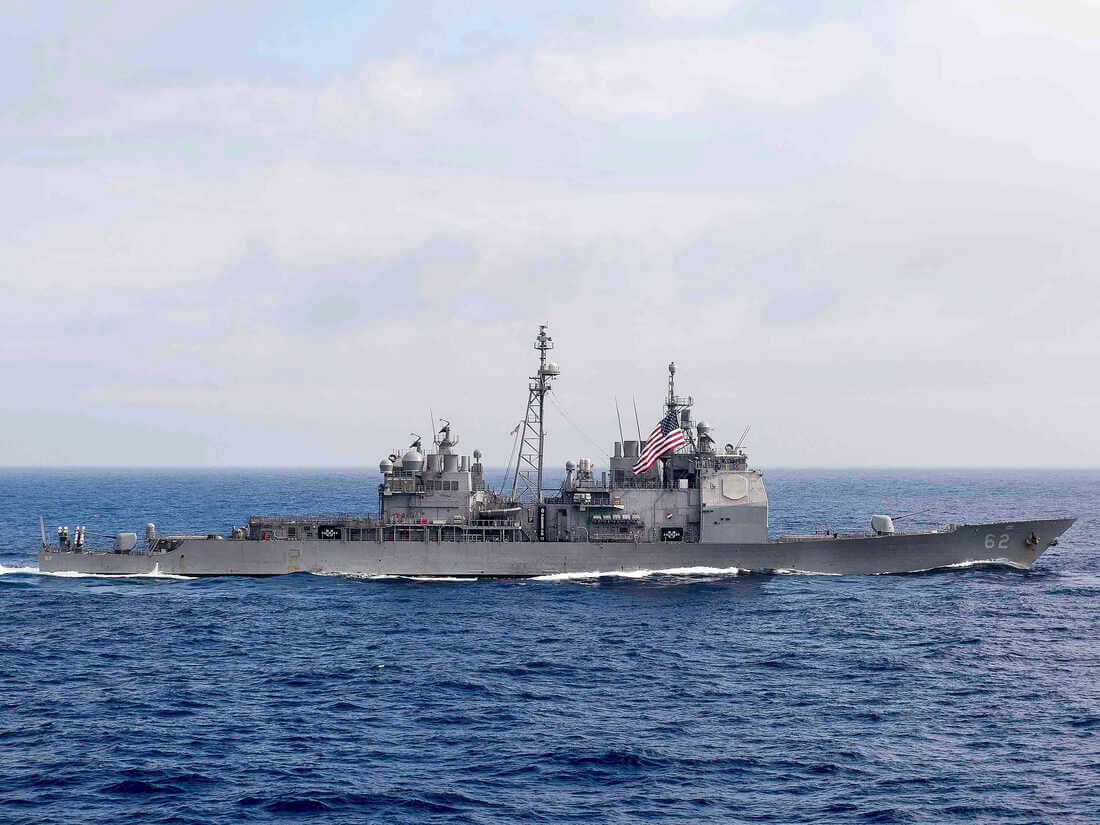Two United States (US) Navy warships are sailing through the Taiwan Strait for the first time since tensions between China and the US peaked over US House Speaker Nancy Pelosi’s visit to Taiwan.
Speaking on the condition of anonymity, three US officials confirmed to Reuters on Saturday that US Navy cruisers USS Chancellorsville and USS Antietam are carrying out a “routine transit.” They added that such operations usually take eight to 12 hours to finish and are closely monitored by the Chinese military.
John Kirby, a spokesperson for Washington’s National Security Council, told CNN’s Jim Sciutto on Sunday that the transiting warships had sent a “very clear” and “very consistent” message that “the United States military will sail, fly and operate wherever international law permits us to do so.” He added that the mission “was planned long ago.”
Cruisers USS Antietam and USS Chancellorsville each receive fuel from the replenishment oiler USNS Tippecanoe while operating in the Philippine Sea. Both cruisers are on station in the region conducting routine operations. #FreeandopenIndoPacific@MSCSealift @US7thFleet @USNavy pic.twitter.com/KQjChf3Orh
— U.S. Pacific Fleet (@USPacificFleet) August 22, 2022
Defending its right to passage, the US 7th Fleet in Japan said in a statement that the ships “transited through a corridor in the strait that is beyond the territorial sea of any coastal state.” It added that the operation demonstrated Washington’s “commitment to a free and open Indo-Pacific,” and that the vessels were voyaging “through waters where high seas freedoms of navigation and overflight apply in accordance with international law.” It also noted that there had been “no interference from foreign military forces so far.”
In response to the passage, the People’s Liberation Army’s (PLA) Eastern Theater Command spokesperson, Shi Yi, said in a statement on Sunday that “the theatre command’s troops keep high alert and are fully prepared to crackdown any provocation anytime.”
Commenting on the transit, experts cited by Chinese state-owned media house Global Times said that as long as the US vessels follow the rules of “innocent passage,” which include keeping a “low profile,” posing no harm, turning off the vessel’s weapons and fire-control radar system, and do not pose a real threat to China’s security, the PLA would simply “follow and monitor” the vessels. They also noted that there was “no big difference” in this passage, “as the US also doesn’t want to put its old warships in danger.”
China’s PLA monitored the entire passage of USS Antietam and USS Chancellorsville through the Taiwan Strait and had everything under control. Chinese troops remain on high alert and are ready to thwart any provocation: spokesperson for PLA Eastern Theater Command, Sun. pic.twitter.com/IxvfCRY5jG
— Zhang Meifang张美芳 (@CGMeifangZhang) August 28, 2022
Song Zhongping, a Chinese military expert, warned that US warships, “whether cruisers, destroyers or even aircraft carriers,” would not be able to “survive in the Taiwan Strait” during wartime and would fail to “survive the saturation attacks launched by the PLA’s land-based missiles.” “So if the US Navy wants to deter the PLA, sailing through the Taiwan Straits is actually pointless and meaningless,” he declared.
Beijing has often criticised Washington for its maritime “provocations” in the past. However, the US Navy has consistently argued that “under international law as reflected in the Law of the Sea Convention, the ships of all states, including their warships, enjoy the right of innocent passage through the territorial sea.” On this basis, the US Navy frequently carries out such missions in the region to challenge Chinese territorial claims.
The latest operation is the first of its kind since tensions between Beijing and Washington peaked to an all-time high in recent weeks, following Pelosi’s visit to the self-governing island, which China claims to be part of its own territory. In retaliation, the PLA’s Eastern Theatre Command carried out joint combat training exercises in the waters and airspace around Taiwan. Its exercise focused on testing the capabilities of using joint fires to strike land and long-range air targets. It deployed various types of warplanes, including early warning aircraft, bombers, jamming aircraft, fighter-bombers, and fighter jets.
Furthermore, the country’s Maritime Safety Administration announced five exclusion zones in the Yellow Sea where it held exercises from August 5 to 15. It also announced an additional four zones in the Bohai Sea, where month-long military operations are taking place.
As part of its other countermeasures against the US’ provocation, China also announced the suspension of a series of coordination measures.

